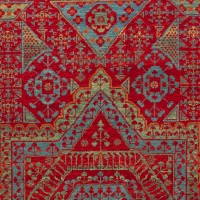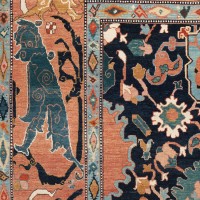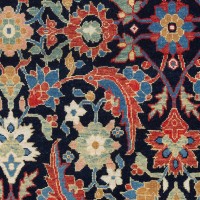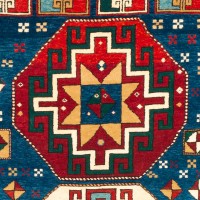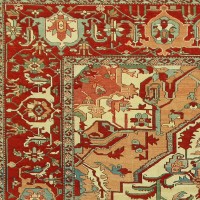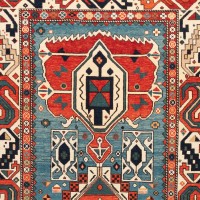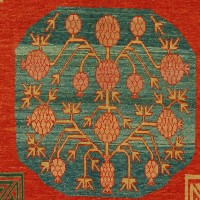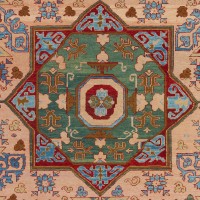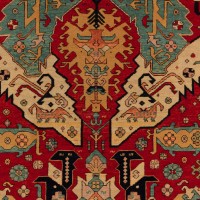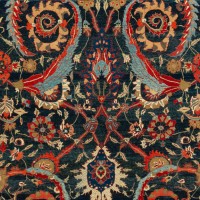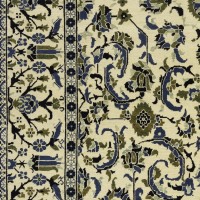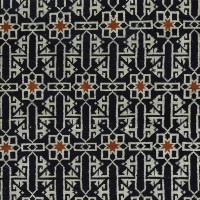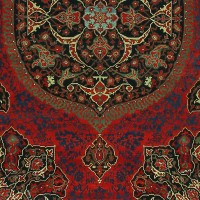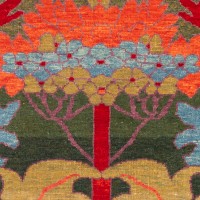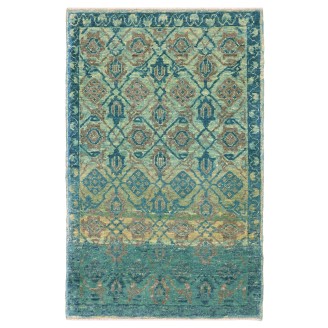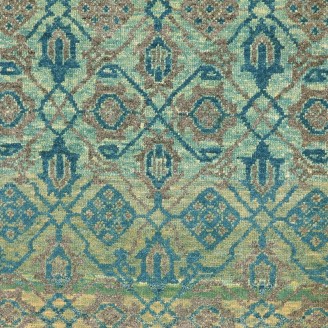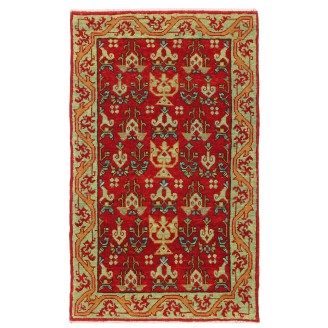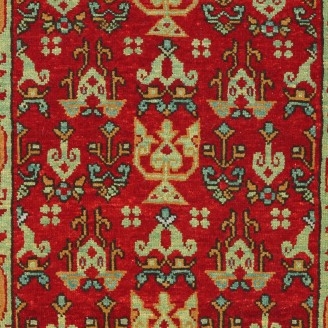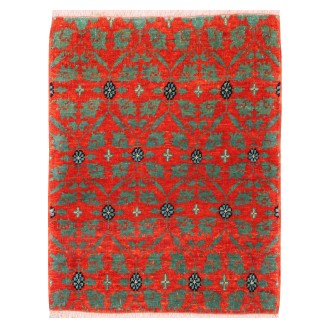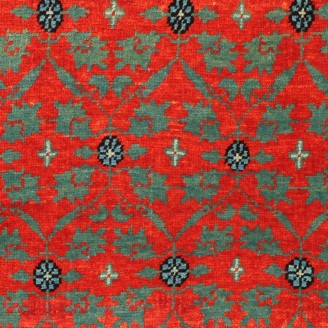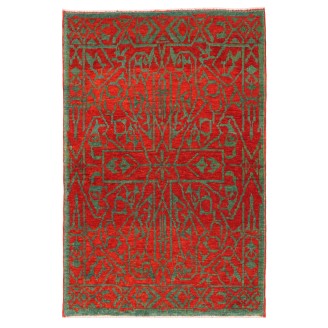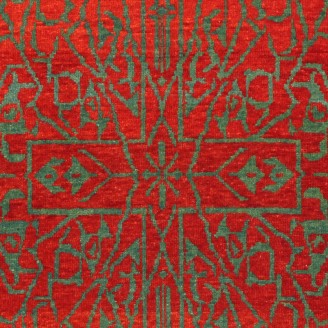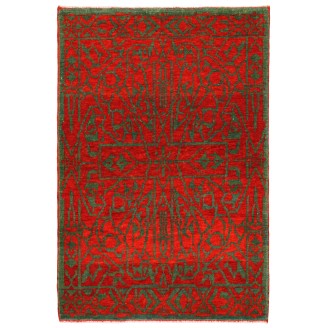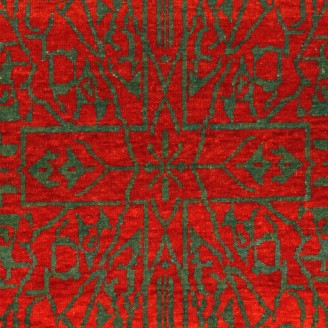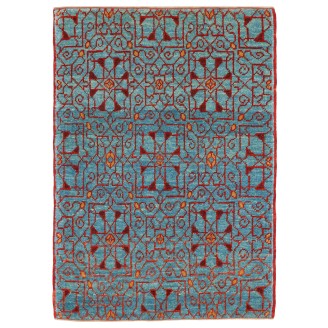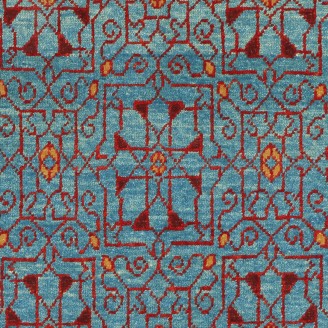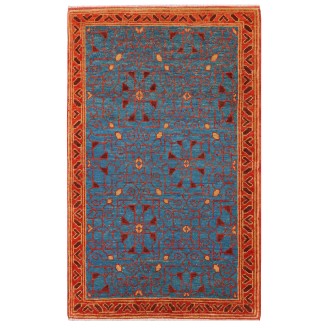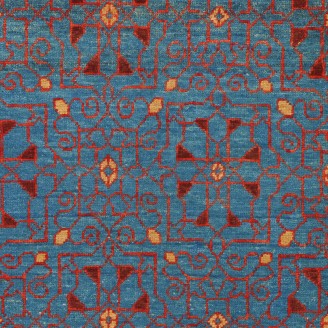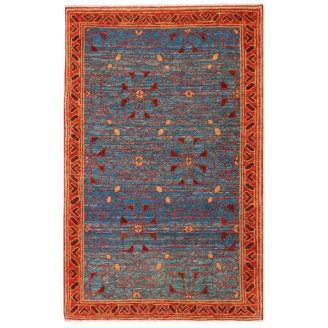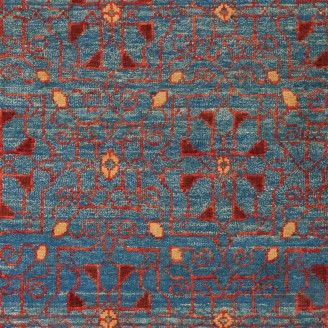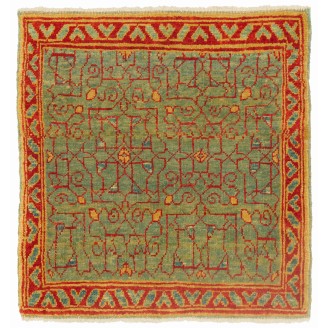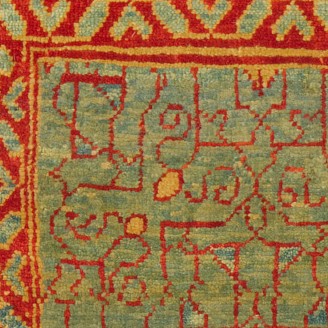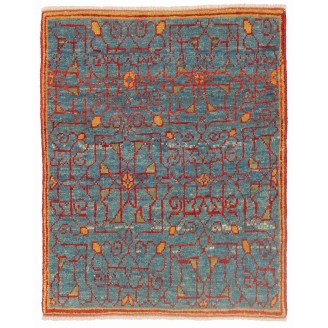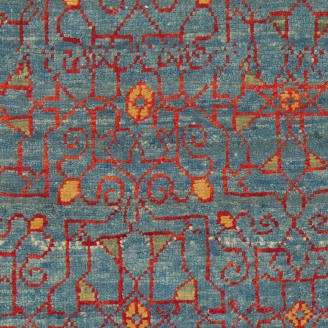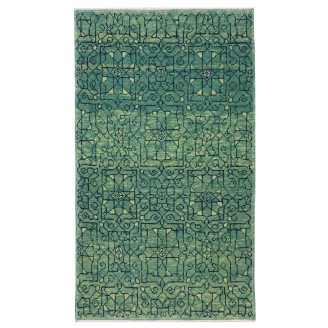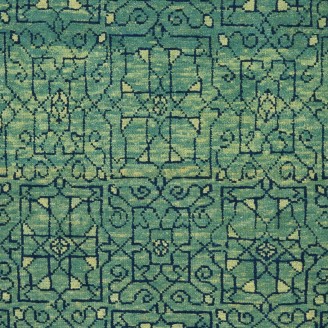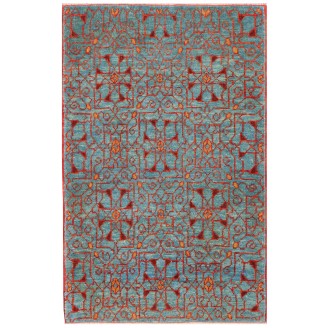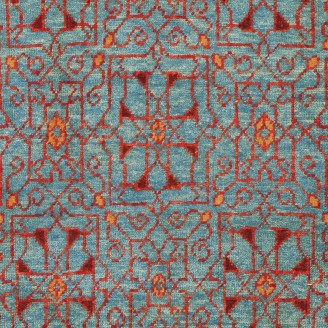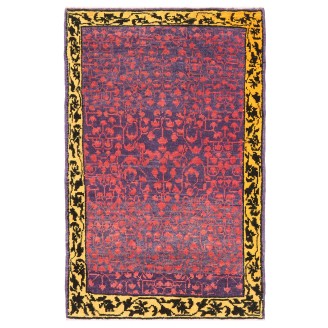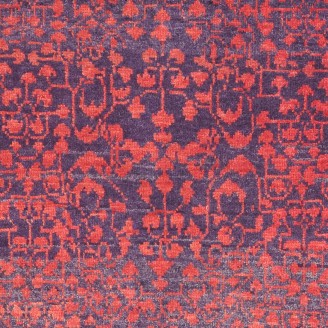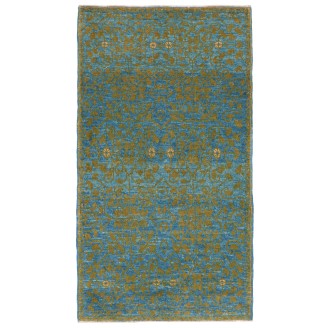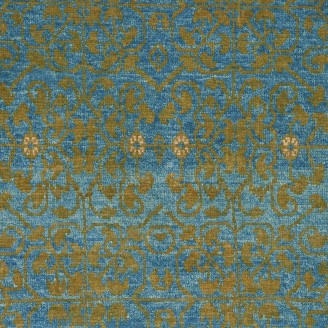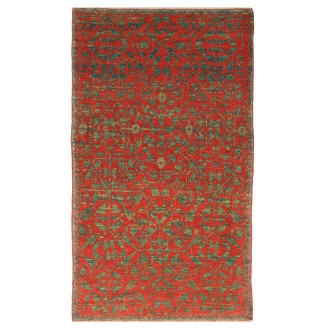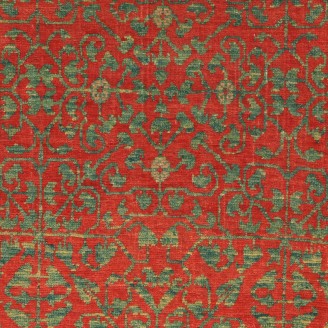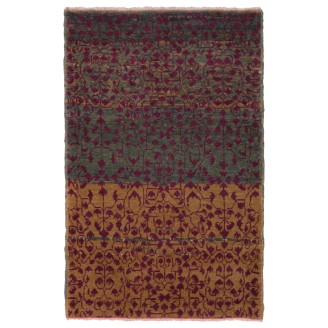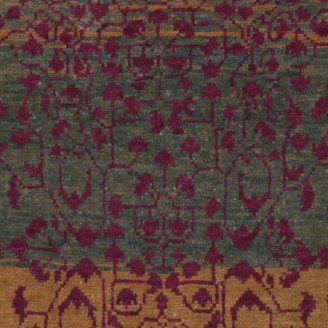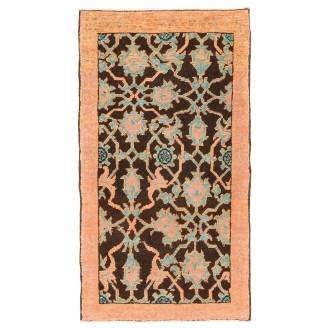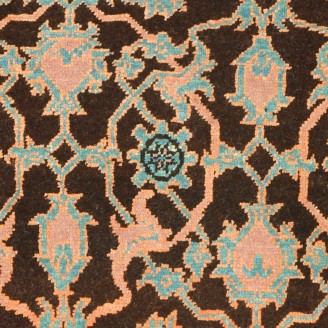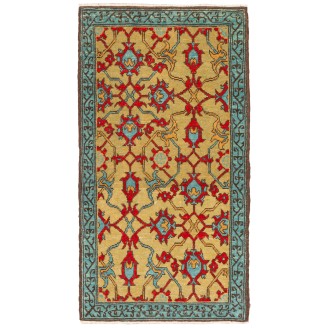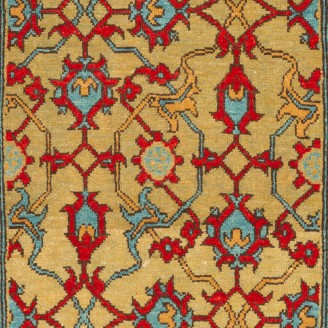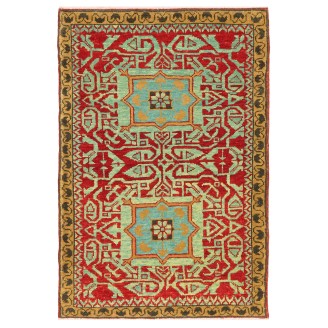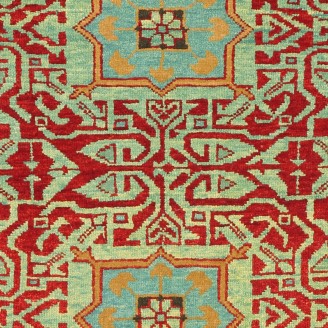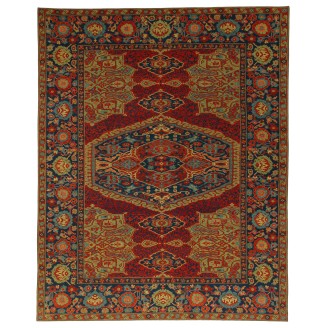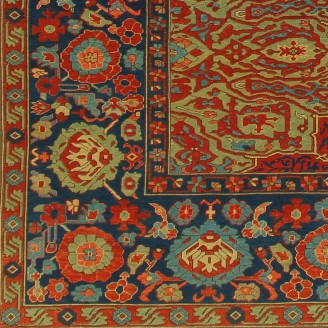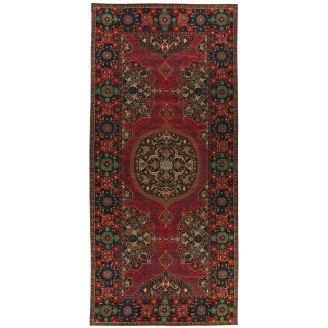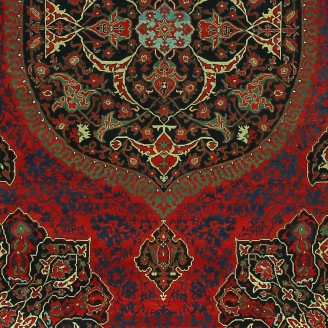Model: ART00222
Dimensions: 1'9" X 2'9"(54cm x 84cm)
This lattice pattern is composed of palmettes and leaves filling the various compartments against the imposing ground. One has the impression that it is only part of a larger scheme designed 15th-century rug from the Mamluk era, Cairo region, Eygpt. These designs have often been described as wagireh..
Price:
$825
Ex Tax:$825
Model: ART00172
Dimensions: 1'8" X 2'9"(52cm x 84cm)
The source of the rug comes from the possession of Endre Unger, which was sold at Sotheby’s in 1992. That rug with the central star was designed in the early 16th-century rug by Mamluk Sultane of Cairo, Egypt. The interpreted design is composed of candelabra Elems and motifs rows filling the various..
Price:
$825
Ex Tax:$825
Model: ART00076
Dimensions: 1'9" X 2'3"(55cm x 69cm)
The source of carpet comes from the book Völker, Angela, Die orientalischen Knüpfteppiche das MAK, Vienna: Böhlau, 2001: 42–5. This rug with the central star was designed in the early 16th-century rug by Mamluk Sultane of Cairo, Egypt. It is exhibited at MAK – Museum of Applied Arts, Vienna Austria...
Price:
$300
Ex Tax:$300
Model: ART00099
Dimensions: 1'8" X 2'7"(53cm x 79cm)
This geometric lattice pattern rug has the impression that it is only part of a larger scheme designed 15th-century rug from the Mamluk era, Cairo region, Eygpt. These designs have often been described as wagirehs or samplers and were said to have been used as weaver`s aids, or for demonstration pur..
Price:
$825
Ex Tax:$825
Model: ART00095
Dimensions: 1'9" X 2'6"(54cm x 78cm)
This geometric lattice pattern rug has the impression that it is only part of a larger scheme designed 15th-century rug from the Mamluk era, Cairo region, Eygpt. These designs have often been described as wagirehs or samplers and were said to have been used as weaver`s aids, or for demonstration pur..
Price:
$825
Ex Tax:$825
Model: ART00131
Dimensions: 1'10" X 2'6"(56cm x 77cm)
The source of the rug comes from the possession of Endre Unger, which was sold at Sotheby’s in 1992. That rug with the central star was designed in the early 16th-century rug by Mamluk Sultane of Cairo, Egypt. The interpreted design is composed of Jerrehian rug's border motifs lattice, covering the ..
Price:
$825
Ex Tax:$825
Model: ART00132
Dimensions: 1'10" X 2'11"(57cm x 90cm)
The source of the rug comes from the possession of Endre Unger, which was sold at Sotheby’s in 1992. That rug with the central star was designed in the early 16th-century rug by Mamluk Sultane of Cairo, Egypt. The interpreted design is composed of Jerrehian rug's border motifs lattice, covering the ..
Price:
$825
Ex Tax:$825
Model: ART00133
Dimensions: 1'10" X 2'11"(57cm x 91cm)
The source of the rug comes from the possession of Endre Unger, which was sold at Sotheby’s in 1992. That rug with the central star was designed in the early 16th-century rug by Mamluk Sultane of Cairo, Egypt. The interpreted design is composed of Jerrehian rug's border motifs lattice, covering the ..
Price:
$825
Ex Tax:$825
Model: ART00109
Dimensions: 1'8" X 1'9"(53cm x 55cm)
The source of the rug comes from the possession of Endre Unger, which was sold at Sotheby’s in 1992. That rug with the central star was designed in the early 16th-century rug by Mamluk Sultane of Cairo, Egypt. The interpreted design is composed of Jerrehian rug's border motifs lattice, covering the ..
Price:
$600
Ex Tax:$600
Model: ART00110
Dimensions: 1'6" X 1'10"(46cm x 56cm)
The source of the rug comes from the possession of Endre Unger, which was sold at Sotheby’s in 1992. That rug with the central star was designed in the early 16th-century rug by Mamluk Sultane of Cairo, Egypt. The interpreted design is composed of Jerrehian rug's border motifs lattice, covering the ..
Price:
$400
Ex Tax:$400
Model: ART00096
Dimensions: 1'8" X 2'10"(51cm x 88cm)
The source of the rug comes from the possession of Endre Unger, which was sold at Sotheby’s in 1992. That rug with the central star was designed in the early 16th-century rug by Mamluk Sultane of Cairo, Egypt. The interpreted design is composed of Jerrehian rug's border motifs lattice, covering the ..
Price:
$0
Ex Tax:$0
Model: ART00130
Dimensions: 1'9" X 2'9"(55cm x 84cm)
The source of the rug comes from the possession of Endre Unger, which was sold at Sotheby’s in 1992. That rug with the central star was designed in the early 16th-century rug by Mamluk Sultane of Cairo, Egypt. The interpreted design is composed of Jerrehian rug's border motifs lattice, covering the ..
Price:
$825
Ex Tax:$825
Model: ART00162
Dimensions: 1'7" X 2'6"(50cm x 77cm)
The source of carpet comes from the book Völker, Angela, Die orientalischen Knüpfteppiche das MAK, Vienna: Böhlau, 2001: 42–5. That rug with the central star was designed in the early 16th-century rug by Mamluk Sultane of Cairo, Egypt. It is exhibited at MAK – Museum of Applied Arts, Vienna Austria...
Price:
$825
Ex Tax:$825
Model: ART00163
Dimensions: 1'8" X 2'11"(51cm x 90cm)
The source of carpet comes from the book Völker, Angela, Die orientalischen Knüpfteppiche das MAK, Vienna: Böhlau, 2001: 42–5. That rug with the central star was designed in the early 16th-century rug by Mamluk Sultane of Cairo, Egypt. It is exhibited at MAK – Museum of Applied Arts, Vienna Austria...
Price:
$0
Ex Tax:$0
Model: ART00164
Dimensions: 1'8" X 2'11"(53cm x 89cm)
The source of carpet comes from the book Völker, Angela, Die orientalischen Knüpfteppiche das MAK, Vienna: Böhlau, 2001: 42–5. That rug with the central star was designed in the early 16th-century rug by Mamluk Sultane of Cairo, Egypt. It is exhibited at MAK – Museum of Applied Arts, Vienna Austria...
Price:
$825
Ex Tax:$825
Model: ART00159
Dimensions: 1'7" X 2'5"(50cm x 74cm)
The source of carpet comes from the book Völker, Angela, Die orientalischen Knüpfteppiche das MAK, Vienna: Böhlau, 2001: 42–5. That rug with the central star was designed in the early 16th-century rug by Mamluk Sultane of Cairo, Egypt. It is exhibited at MAK – Museum of Applied Arts, Vienna Austria...
Price:
$825
Ex Tax:$825
Model: ART00173
Dimensions: 1'7" X 3'0"(50cm x 93cm)
This rug has an interpreted design composed of a palmette lattice pattern taken from a part of the Mamluk rug, filling the field elegantly. These kinds of rugs have often been described as wagirehs or samplers and were said to have been used as weaver`s aids, or for demonstration purposes, made as a..
Price:
$825
Ex Tax:$825
Model: ART00174
Dimensions: 1'8" X 3'1"(52cm x 95cm)
This rug has an interpreted design composed of a palmette lattice pattern taken from a part of the Mamluk rug, filling the field elegantly. These kinds of rugs have often been described as wagirehs or samplers and were said to have been used as weaver`s aids, or for demonstration purposes, made as a..
Price:
$825
Ex Tax:$825
Model: ART00167
Dimensions: 1'8" X 2'6"(53cm x 78cm)
The source of the rug comes from the Baillet-Latour Mamluk Carpet, Vienna Book(1892) and Sarre-Trenkwald(1926, pl.48). That carpet was designed in the early 16th-century rug by Mamluk Sultane of Cairo, Egypt. It was sold at Christie's London on 8 April 2014 and purchased by the Louvre Museum. It is ..
Price:
$0
Ex Tax:$0
Model: ARTW0024
Dimensions: 10'7" X 13'3"(325cm x 404cm)
The source of the carpet comes from the book How to Read – Islamic Carpets, Walter B. Denny, The Metropolitan Museum of Art, New York 2014 fig.58 and Antique Rugs from the Near East, Wilhelm von Bode and Ernst Kühnel, Klinkhardt & Biermann, Berlin 1958, pg.40 and Oriental Carpets in the Museum of Is..
Price:
$0
Ex Tax:$0
Model: ARTW0025
Dimensions: 11'6" X 24'11"(352cm x 760cm)
The source of the carpet comes from the book How to Read – Islamic Carpets, Walter B. Denny, The Metropolitan Museum of Art, New York 2014 fig.58 and Antique Rugs from the Near East, Wilhelm von Bode and Ernst Kühnel, Klinkhardt & Biermann, Berlin 1958, pg.40 and Oriental Carpets in the Museum of Is..
Price:
$0
Ex Tax:$0
